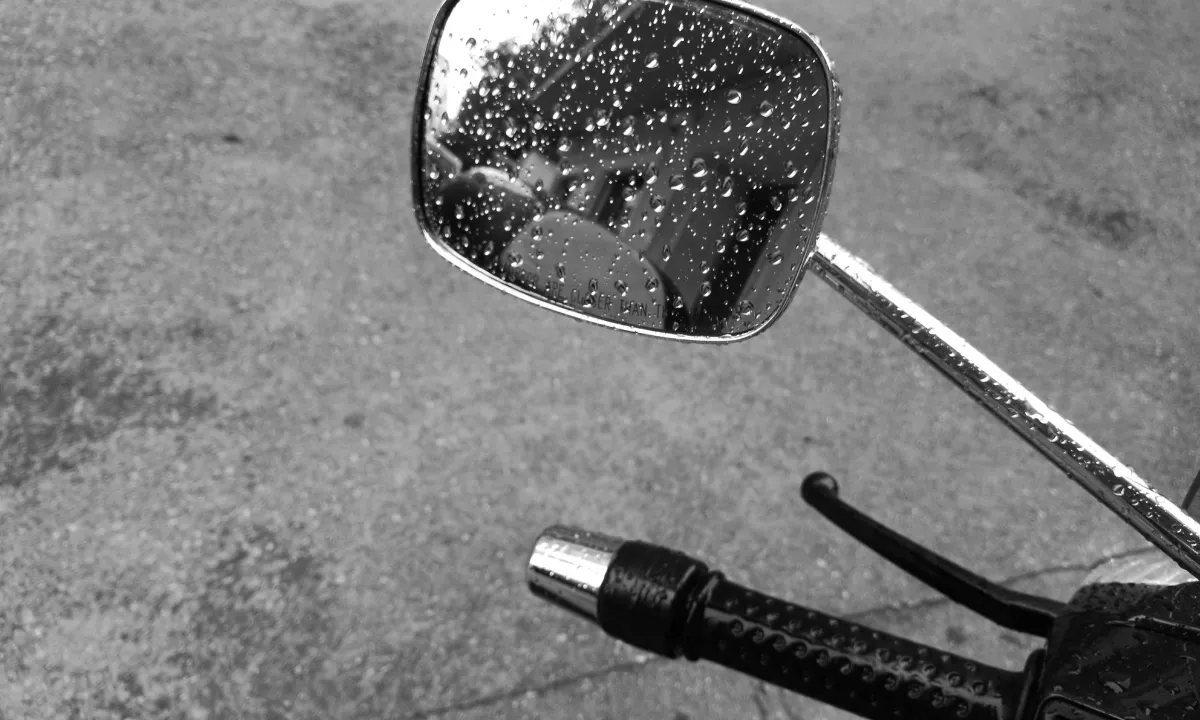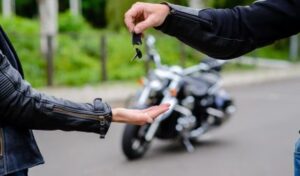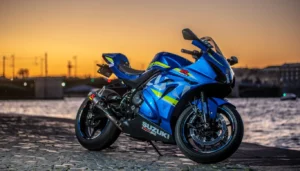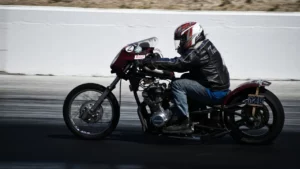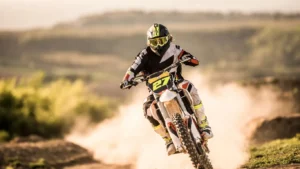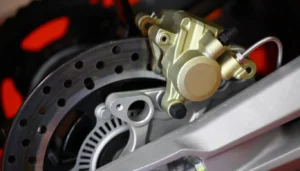I want to share a personal story about getting caught in a rainstorm while riding my motorcycle.
So, sometimes I forgot to put my motorcycle in the garage and left it out in the driveway, where it was destroyed by a heavy rainstorm or snowstorm.
When a motorcycle gets wet like this, many people are concerned for its safety and wonder if it is safe to do so.
The majority of motorcycles are made in such a way that getting them wet has no negative effects. It is also undoubtedly true that prolonged exposure to water can harm your motorcycle.
If you ride a motorcycle constantly, it is sure that at some point you will get stuck in bad weather. While a good water rinse won’t cause damage, there are things to consider when your motorcycle gets stuck in rain and/or snow.
What Happens To Your Motorcycle After Being in Water For A Long Time?
We would like to tell you that sometimes coming in contact with water does not harm the motorcycle. People often have this question:
What is the potential damage that water can cause to a motorcycle over time?
So the answer is “yes,” because you have to keep in mind that it will take a long time for water to start damaging your motorcycle.
If the motorcycle is left in water for too long (meaning there is no cover in extreme rain storms for several months), it will start to have problems.
Despite the fact that motorcycles are designed and built in such a way that water cannot penetrate them, water has the potential to damage parts of them.
1. Water can mix with your engine oil
The water will try to find its way into your engine and your carburetors.
Once it’s driven inside your engine, you’ll have a hard time starting your motorcycle while on the go. because water can mix with your engine oil and require an oil change.
2. Rust can seize the engine
Although it is fixable, it is still a headache. Corrosion becomes a major concern when water contacts metal parts.
The water will also collect any grime or simple dirt, which creates “gunk.” And so you will need to rebuild your carbs and do a thorough cleaning.
3. Lack of lubrication
Riding a motorcycle without a lubricated chain is dangerous, so it’s important to do routine check-ups.
If you’re concerned about a lack of lubrication in your chain, go ahead and lubricate it. Water can eventually break down the lubrication of your chain, if you have one.
4. Gas that has been mixed with water
It’s also possible for water to get into the fuel tank and lines of your motorcycle.
Because of this, having gas that has been mixed with water in the gas tank of your motorcycle will not cause it to start, and having water in the gas tank is a very risky thing to do.
Even though it’s not the safest thing in the world to do, riding your motorcycle during a rainy season isn’t necessarily going to put you in any immediate danger.
5. Tires loses grip
When a tire or set of tires loses grip on the road because of water, the bike starts to hydroplane.
And the chances of ending up in this situation are high. If you’re taking good care of your motorcycle and don’t have bald tires, you should feel good. Remember to drive at a slow speed during snow or rain.
Motorcycles weigh so little that hydroplaning can be even easier on a motorcycle than on a car. It is really natural to become skittish and stressed out while riding a motorcycle in the rain.
Because it provides a frightening experience. Remember to relax in such a situation and remain a safe and defensive driver.
If you’ve never ridden a motorcycle in the rain, maybe give it a try once or twice. As I said before, you will get caught in an unexpected rainstorm sooner or later. Practising riding in the rain in a controlled environment will help you when you’re hit by amazingly bad weather.
How Do You Ride A Motorcycle in The Rain?
It’s easy to disregard caution when it’s wet, but the same idea leads to motorcycle accidents.
If you are ready for a storm while riding your motorcycle, you are much less likely to get into an accident.
Every road is different, so look for potholes and low spots and stay away. Try to ride on the driest part of your lane.
Too many motorcycles don’t have emergency flashers, so I go in the slow lane and put on my emergency flashers.
In that scenario, I just switch my blinker back and forth so that it catches people’s attention. The biggest danger in a thunderstorm isn’t rain; other drivers are not paying attention.
Avoid driving over any painted lines on the road. It consists of yellow and white lines and symbols.
This paint is incredibly slippery and is perfect for making motorcycle slides. And so your chances of falling are very high.
If you are riding at high speed, avoid driving through puddles if possible. This will increase your chances of hydroplaning.
You don’t even know what’s under the puddle; it could possibly be a pothole. If you are unable to avoid it, slow down as much as you can and proceed with caution.
If you are riding your motorcycle while it is dry and it starts to rain, be extra cautious and go slow. The onset of a rainstorm creates a new mixture with all the oil and dirt on the road, making it more greasy. Avoid any rainbow-colored puddles, as this can be a sign of mixed oil.
You should never forget to keep a safe distance between your bike and other vehicles on the road.
When it is dry, you should make plans to break it down as quickly as possible,because it’s possible for water to get inside your motorcycle’s braking system and delay how quickly the brakes react.
How Can I Stay Dry While Riding a Motorcycle in the Rain?
This is especially relevant if you are surprised by a rainstorm. It will be difficult to always stay dry when riding in the rain because there is water everywhere.
If you know you will be riding your motorcycle in the rain, here are some tips on how to stay dry in the rain.
The very first solution is to wear a full-face motorcycle helmet. Nothing can be more annoying and dangerous than water constantly splashing on your face at high speed. A full-face helmet will help in this regard.
And be sure to try adding some Rain-X outside the face shield.
This will repel water splashing on it, making your visibility more clear and making it easier for you to ride a bike in the rain. Wipe the inside of your face shield with an anti-fog treatment.
Putting on an umbrella or raincoat is yet another option. Your riding experience can be made a little bit more comfortable by wearing waterproof boots and gloves as well.
You could also use a poncho, but if you have something that can be tied tightly around your wrists and waist, that will work much better.
Any bright color like blue, yellow, green, or orange is a great way to make sure drivers will see you during a rainstorm. So if possible, wear high-visibility clothing. Buy a colored reflective vest and put it over your coat, or even better, buy a high-visibility raincoat with reflectors on it.
There are some questions related to this, such as how tall you need to be to ride a motorcycle.
You should be able to touch the ground with your toes and the balls of your feet on either side. To safely steer a motorcycle, you must be able to mount the motorcycle without assistance.
Do I Need To Hand-Signal Another Ride While Riding A Motorcycle in Rain?
The right answer is “no,” because you don’t have to use hand signals when you’re driving a motorcycle.
This is especially true when all of the lights and blinkers on the motorcycle are in good working order, as is the case in most situations.
Having said that, if the power suddenly goes out, the only thing that will be of assistance to you is if you are aware of the most basic warning signs.
Conclusion
Through this article, you have been provided with information related to riding a motorcycle in the rain and precautions to keep your bike and yourself dry. Where does it say how to keep the bike dry in the rain?
Should the bike be allowed to get wet in heavy rain or not? We have also tried to explain in this article how to keep yourself safe during the rain.
Also, ride the bike slowly. We feel that all the information related to rain and motorcycles is available. However, keep in mind that if your motorcycle gets wet in the rain, it will sometimes rain; run, but not too far, as this could cause engine damage.
Also, if you drive fast in heavy rain, then the chances of slipping and falling are very high. To protect yourself, opt for a bright-colored raincoat.
